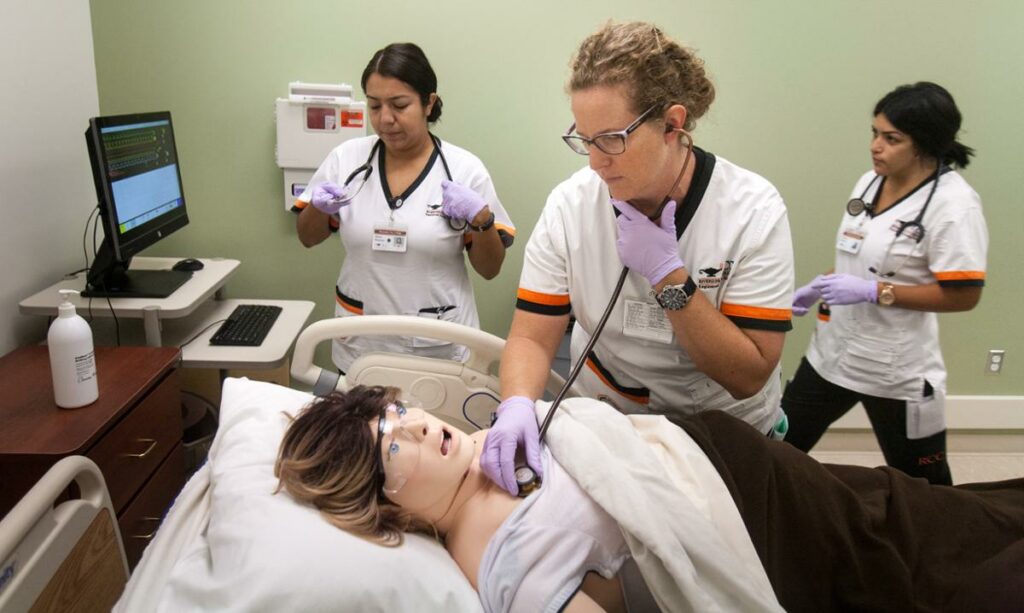
Credit: Riverside City College / RCC.edu
Community college leaders will once again attempt to offer bachelor’s degrees in nursing, renewing a fight with the state’s universities over whether expanding to the two-year sector eases California’s nurses shortage or increases competition.
The bill, authored by state Sen. Richard Roth, D-Riverside, would allow 15 yet-to-be-selected community college districts that already provide associate degrees in nursing to offer bachelor’s degrees in the field.
While California State University has yet to take a position on Roth’s bill, it’s clear the system has a stake in whether community colleges are allowed to serve students who may otherwise attend CSU or private school programs.
The majority of bachelor’s and advanced nursing degree programs are taught by independent and private colleges, which hold about 51% of the market. Statewide, there are 48 bachelor’s degree nursing programs. At least 17 Cal State campuses and six University of California campuses offer a bachelor’s or master’s nursing program within their systems.
Enrollment in bachelor’s nursing programs has also increased statewide, with much of the growth in the private sector. In 2021, 9,179 new students entered these programs — nearly 2,500 more than the previous year, according to a 2023 state nursing board report conducted by UC San Francisco. Meanwhile, fewer students are enrolling in associate degree nursing programs, which are mostly at public community colleges.
“The workforce need has only grown,” said Kaylie Schmidt, a spokesperson with the Community College League of California, a nonprofit organization advocating in favor of the bill, SB 895. “We have nursing shortages like we’ve never seen before, and many of our districts are in communities that have workforce shortages.”
Schmidt said in some areas of the state, nursing students will leave their smaller communities that are in desperate need of health care professionals and migrate to other regions that offer them an opportunity to pursue the bachelor’s nursing degree.
Some estimates show that California is facing a shortage of about 36,000 licensed nurses — a need that is expected to grow “substantially by 2030,” said Andra Hoffman, a trustee for the Los Angeles Community College District. “This tremendous gap continues to widen as current nursing baccalaureate degree programs have demand greater than their enrollment capacity,” she said.
This isn’t the first time the community colleges have pushed the Legislature to approve offering nursing baccalaureate degrees. Ten years ago, the state’s community colleges began offering bachelor’s degrees in certain programs and at specific colleges to address unmet workforce needs. Back then, community college leaders warned that nursing shortages would continue if California didn’t allow the community colleges to offer nursing degrees. The state approved the pilot community college bachelor’s degree program but excluded nursing because state law bars the colleges from offering programs already offered by the universities.
SB 895, which would change that law, is expected to be heard by the Senate Education Committee on April 10.
Rehman Attar, Cal State’s director of health care and workforce development, said CSU has not taken a formal position on the bill but welcomes the Legislature to fix the problems like clinical placements and faculty shortages in nursing education within all three systems.
Registered nurses are not legally required to have a bachelor’s degree to practice. But a growing number of employers and health facilities require registered nurses to have, or be in pursuit of, a bachelor’s degree. A 2010 Institute of Medicine report recommended that the proportion of registered nurses with bachelor’s degrees increase to 80% by 2020. Meanwhile, in California, a 2021 Health Impact report found more than 54% of the state’s hospitals preferred hiring nurses with bachelor’s degrees.
A common misconception is that increasing the capacity of BSN-trained nurses at CSU would solve the nursing shortage, Attar said.
Instead, the problem is much larger than that, he said. Solving it means increasing more capacity for students to get clinical training and hiring more faculty to teach the courses for the community colleges and the universities.
“That’s a big limiting factor and a bottleneck for us to increase capacity,” Attar said.
Both associate degree and bachelor’s degree nursing programs require practical experience, or clinical education, in health care settings. But many health care facilities have a limited number of spots available to offer that experience to students. Creating new nursing programs would only add more students competing for that limited space. Attar said some universities outside of the CSU system also pay or incentivize for clinical placement spots for their students. Getting students into clinical training is an additional challenge all colleges face. Attar said CSU doesn’t pay or incentivize health care facilities for clinical placement spots because the practice isn’t equitable or fair for all students.
Schmidt said the bill would use clinical space already offered to these community college districts. Would that mean students within a single community college are facing greater competition against each other for clinicals? Schmidt said it would be on the community college to determine how it wants to use the clinical space it has between students earning an associate degree and a bachelor’s degree.
A separate bill authored by Roth, SB 1042, plans to address the clinical placement problem by requiring health facilities to work with public and private nursing programs to attempt to make the necessary number of placements available to them to meet the schools’ demand.
Statewide, there has been growth in nursing programs offering bachelor’s degrees. According to a 2023 report from the California Board of Registered Nursing, the number of bachelor’s programs in the state increased from 43 in 2020 to 48 in 2021. However, that 20% growth in programs took place in the private sector.
Alex Graves, vice president of government relations for the Association of Independent California Colleges and Universities, said the organization has not taken a formal position on SB 895, but they do have concerns about it exacerbating the challenge of finding faculty for bachelor’s nursing programs.
“The reality is if there are additional courses that are going to be required for community colleges to offer BSN programs, it will likely mean there will be additional faculty demands coming for those programs,” he said. “That will just make it all the more difficult for all of us to find those folks to fill those positions in our programs.”
Encouraging qualified nurses to teach in both associate and bachelor’s degree programs has been challenging for nearly all programs because colleges and universities can’t compete with the salaries nurses make working in health care settings.
Although faculty vacancy rates have fluctuated over the years, in 2022, the state nursing board reported a 12.1% faculty vacancy rate — the highest it had been in 10 years. Many colleges have compensated by hiring more part-time nursing faculty, but that hasn’t diminished their need for more faculty overall. The board found nearly 70% of nursing programs reported faculty working “overloaded” schedules, of which 94% reported paying their faculty extra for the additional work.
“We’re fortunate enough that we have doctoral programs that focus on creating nurse educators,” Rehman said, speaking for the CSU system. “But again, that pipeline gets restricted at the associate’s and bachelor’s degree level, so if we’re not able to increase that pipeline of students to become nurses, it restricts us in terms of producing nursing faculty, as well.”
Rehman called it a “domino effect.”
“When we’re able to address these core fundamental nursing issues of clinical placement — and just starting with that — that’s going to start alleviating some of the pains that we find with faculty,” he said.
Addressing the constraints on clinical placements and the shortage of nursing faculty are the best ways to get more nurses into the profession, Graves said.
Instead, Graves said there are better examples of collaboration between community college and university nursing programs that provide a clear path for students to achieve their bachelor’s without compounding the faculty and clinical placement challenges. Those examples are in concurrent enrollment or associate degree to bachelor’s nursing degree programs.
Partnerships
The number of associate degree programs partnering with bachelor’s degree nursing programs has also increased. Private universities and some Cal State campuses have formal concurrent enrollment nursing programs with community colleges that allow students to earn both degrees simultaneously. The state nursing board reported such partnerships have increased over the last 10 years from 50.8% in 2012 to nearly 60% in 2021.
CSU has more than 10 such partnerships across its campuses and wants to add more.
“These ADN to BSN pathways have been really helpful,” Rehman said. “We’ve been able to streamline our curriculum with the community colleges to really reduce the time to graduation. … We’re also having coordination with our clinical placements.”
The partnerships could be an alternative to allowing community colleges to offer the bachelor’s degree directly.
That collaboration with the community colleges creates better clinical placement schedules to get students in and out of the program more quickly. Traditionally, it can take a nursing student up to six years to complete their bachelor’s degree. However, the associate-to-bachelor’s nursing partnerships reduce that time to three to four years, allowing more students to graduate, Rehman said.
“It’s a win-win, and we’re always looking to grow it,” he said. “We’re going to continue to keep on trying to grow it and make it more accessible to all of our community college partners.”


